Edinburgh is Scotland’s old and charming capital, where chill and bagpipe music is seen and heard in the streets. Sandstone buildings, the cozy Old Town, The Royal Mile, breathtaking views from the hills in or near the center and stunningly beautiful surroundings are just some of the other things that come with a visit to the Scottish city.
Literally, Edinburgh Castle is the highlight of the city, with its dramatic location at the top of a cliff top right in the city center. The castle is the center of the city and also the center of the city’s famous tattoo. From Edinburgh Castle, the famous Royal Mile extends east to the Holyroodhouse Castle, and there are countless sights along the mile. Old churches and typical Scottish houses are abundant here.
The 18th-century New Town district is a short walk from the Royal Mile. New Town is constructed according to a strict contemporary street layout. Here you can walk along the grand Princes Street, which serves as one of Edinburgh’s main streets.
Everywhere in town, a Scottish atmosphere is buzzing with shops selling kilts and bagpipes, and Scottish food and drink should be tried as well; it can be haggis and a glass of whisky. Edinburgh is surrounded by beautiful scenery and it is never far to good opportunities for walks in the parks, by the sea and on some of the many hills that is around the city. A hike to Arthur’s Seat is a suggestion.
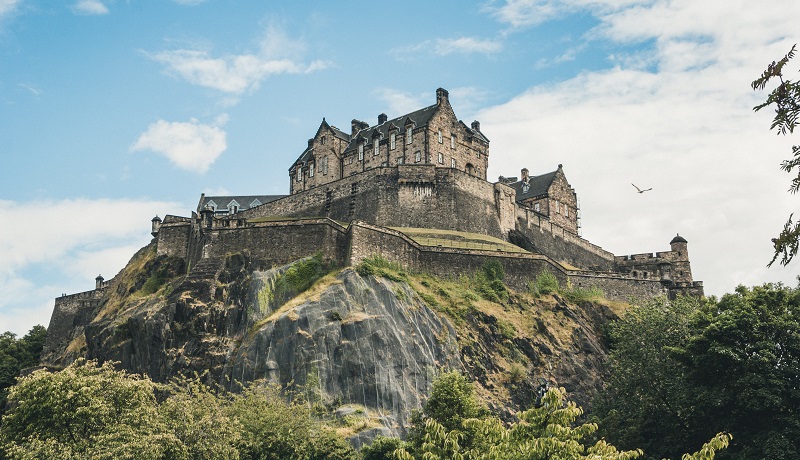
Edinburgh Castle is the city’s famous castle, perched on top of an extinct volcano. There are several museums at the castle which in itself is an experience. This is also where Edinburgh’s annual tattoo is held.
The Royal Mile is Edinburgh’s main street. It consists of Castlehill, Lawnmarket, High Street and Canongate streets. The name comes from the fact that the street is an English mile long and that it connects the city’s two castles.
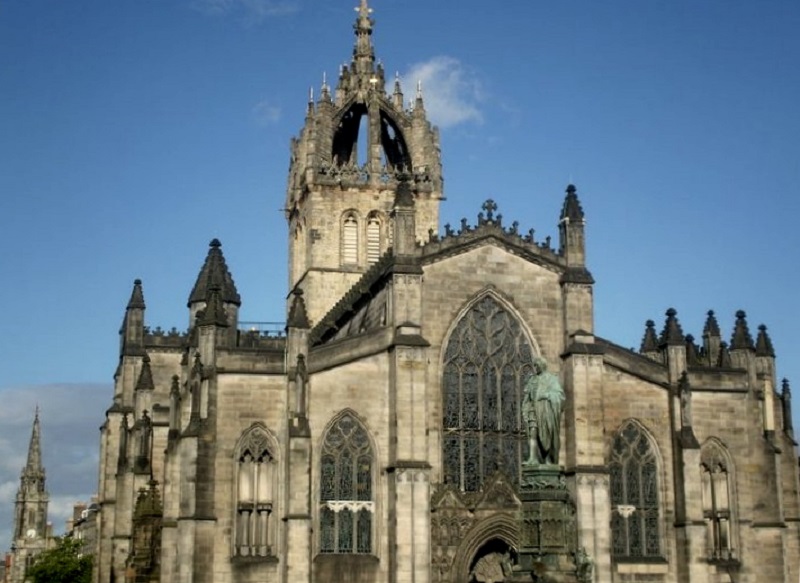
This is Edinburgh Cathedral, which in its current form dates mainly from the 14th and 15th centuries. Here you can e.g. see some of Scotland’s most beautiful glass mosaics.
Located at the east end of the Royal Mile, Holyroodhouse is the residence of the English regent during a stay in Edinburgh. The castle was built in the 16th century and there is access to parts of the large residence.
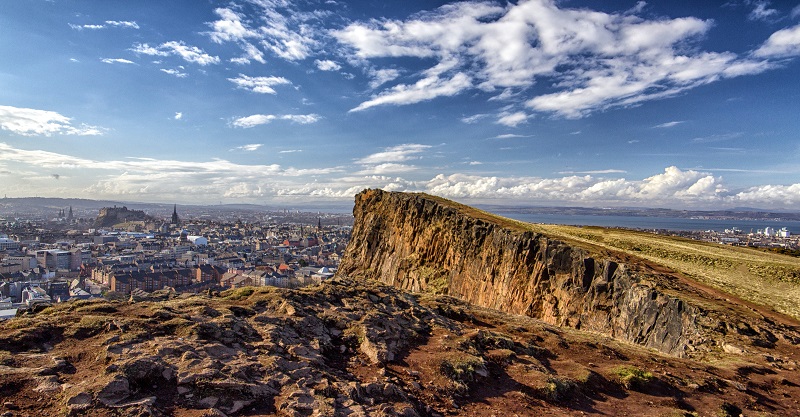
Arthur’s Seat is a 251 meter/823 foot high, extinct volcano located a short distance from Edinburgh city center. It is easy to climb and from the top there is a fantastic view of Edinburgh and the surrounding area.
This is a distinguished museum depicting Scotland from antiquity to the present day. Through more than 10,000 objects, the museum displays various themes related to the history and people of the country.
Charlotte Square is considered the most beautiful and harmonious square in New Town. It was developed in a typical Georgian style and is a UNESCO World Heritage Site.
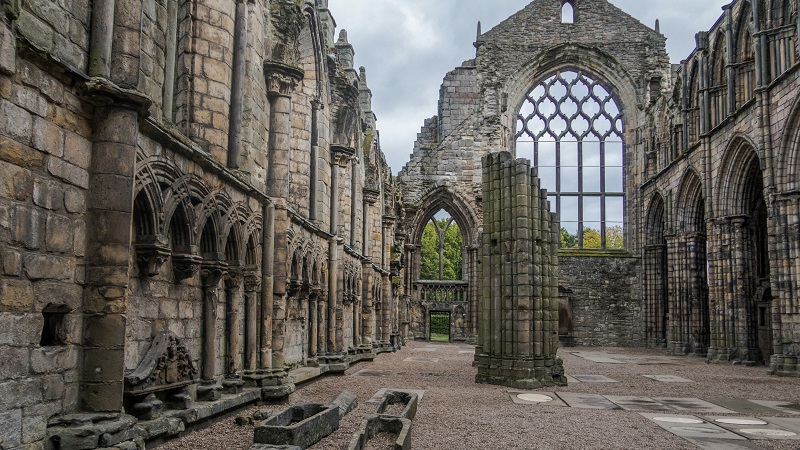
The Church of Holyrood Abbey was founded in 1128 by King David I. Several Scottish kings were buried in the church, Queen Marie Stuart was married here, and King Charles I was crowned here in 1633. Today, Holyrood Abbey is in ruins.
Camera Obscura is the name of one of Edinburgh’s most spectacular sights. The whole of Edinburgh is reflected and thus shown as a living film through rotating mirrors from 1853.
This is Edinburgh’s city history museum, and through its fine collection you can learn about the history of the area and the city from prehistoric times to the present day.
This is an art museum adjacent to the regent’s Holyroodhouse. You can visit and enjoy changing exhibitions of works from the Royal Art Collection.
This is a church from 1612, and it became especially famous in 1638. It was the place where the Scottish Reformation was signed that year. The fine church is today located as an oasis away from the city traffic.
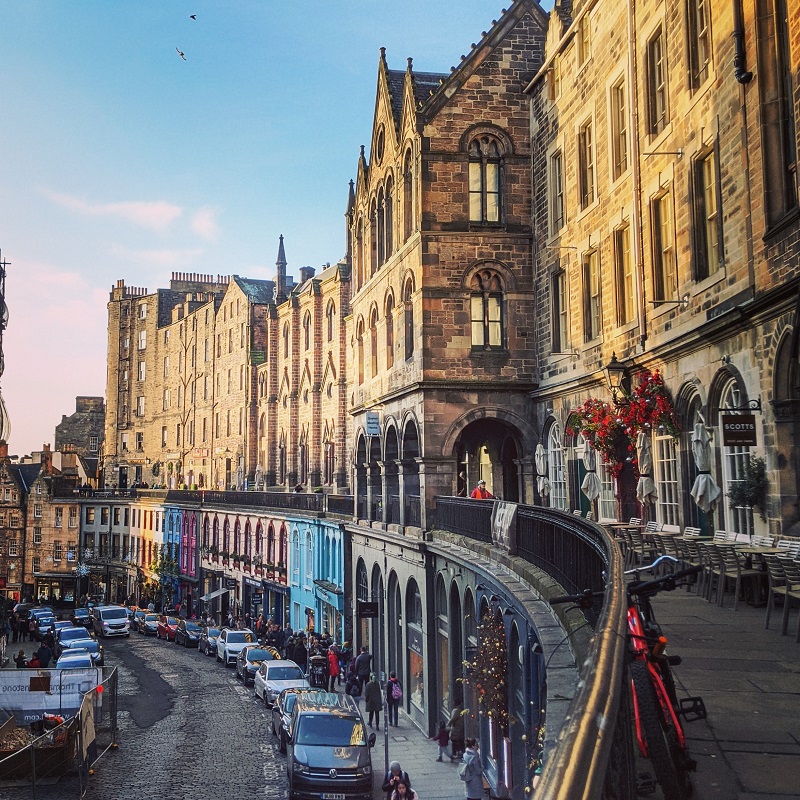
Victoria Street is probably something many people will recognize from photographs from Edinburgh. The street connects the area of the Royal Mile with the Grassmarket, and there are beautifully painted shop facades along the curved course of the road.
The Balmoral Hotel is Edinburgh’s classic upscale hotel. It opened its doors in 1902 as a railway hotel called the North British Hotel. Many celebrities have stayed at the hotel over time.
In this national gallery you can see a depiction of Scotland’s history from the 16th century to the present day through paintings. Here are also other works by i.a. Dali and Picasso.
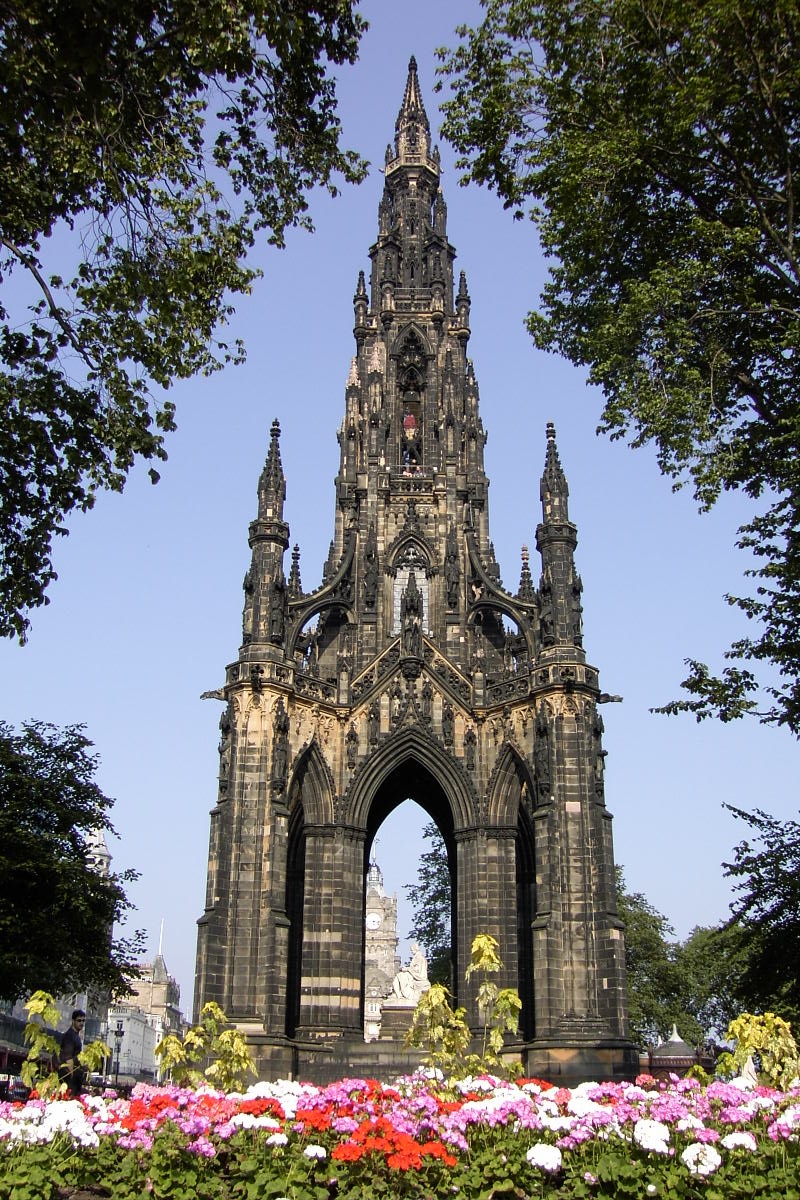
The Scott Monument is a 61 meter/200 foot high monument erected in memory of the Scottish author Sir Walter Scott. The monument was built 1841-1844 with a narrow spiral staircase to a nice view from the top.
Scotland’s National Gallery houses a fine collection of European and Scottish paintings. Here you can see works by Raphael, Velázquez, van Gogh and Gauguin, among others.
Edinburgh’s Botanical Garden is one of the largest in the world when it comes to the number of species, and there are many fine places to see here. It is a park with a Chinese garden, a tropical house, a palm house, an orchid house and a rock garden with waterfalls.

This is a cozy town with several sights, not least the large bridges over the Firth of Forth. The most famous is the Forth Rail Bridge, which is one of the world’s most impressive, historic bridges and an icon for riveted iron bridges.
The port city of Leith is located northeast of Edinburgh. In the city harbor you can see the former British royal ship Britannia, built in 1953 for Queen Elizabeth II. There is access to the ship, which is a museum.
Rosslyn Chapel is a chapel that became extra famous from the book The Da Vinci Code. The chapel was built in the 15th century, and here are fine wood carvings and other beautiful details in the decoration.
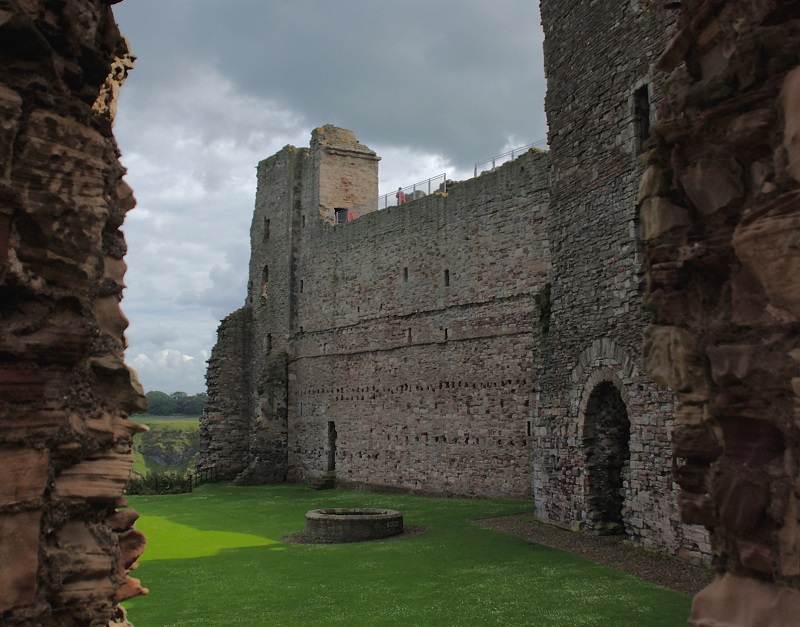
The mighty castle ruins of Tantallon are a sight to behold, breathtakingly situated on top of the dramatic Scottish rocky coastline. The castle was built in the 14th century and belonged to the Douglas family.
This exciting mining museum provides insight into Scotland’s historic mining. The museum is housed in a well-preserved 19th-century coal mine.
The town of Stirling is one of Scotland’s most interesting provincial towns with a rich history and several sights. You can enjoy a walk in the cozy town, where Stirling Castle is the main attraction.
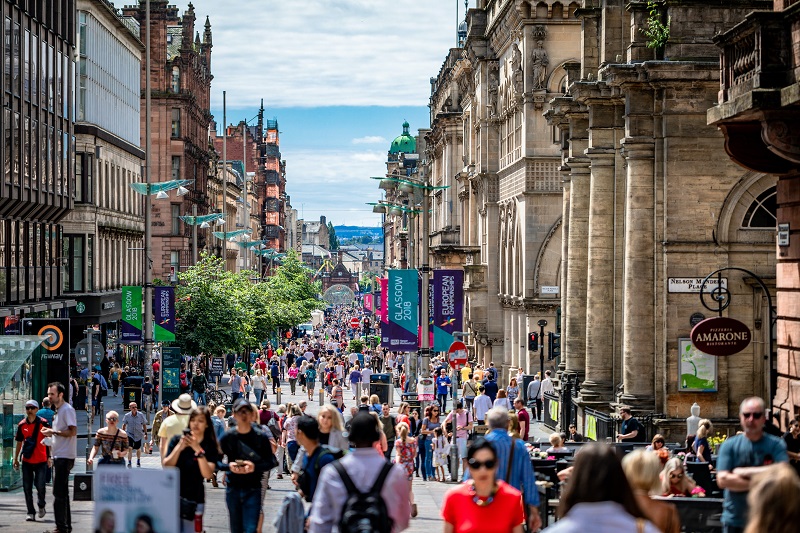
Glasgow is Scotland’s largest city and in Glasgow there are many things to see and do. You can start at George Square, where you can see the town hall and a statue of Walter Scott. You should also see the cathedral and the city’s prestigious museums, where the Kelvingrove Art Museum is the most famous.
6 Lady Road
camerontoll.co.uk
21 Gyle Avenue
gyleshopping.co.uk
48 Princes Street
houseoffraser.co.uk
Ocean Drive, Leith
oceanterminal.com
Leith Street
stjamesshopping.com
Leith Street, Nicolson Street, Princes Street, Royal Mile (Lawnmarket and High Street)
Deep Sea World
North Queensferry, 18 km/11 mi NW
deepseaworld.com
Dynamic Earth
Holyrood Road
dynamicearth.co.uk
Edinburgh Dungeon
31 Market Street
thedungeons.com
Edinburgh Zoo
Corstorphine Road
edinburghzoo.org.uk
Museum of Childhood
42 High Street, Royal Mile
cac.org.uk
Museum of Flight
East Fortune Airfield
nms.ac.uk
The first settlers came to the Edinburgh area around 850 BC The place has obviously been attractive due to the 134 meter high cliff, Castle Rock, which has been able to act as a natural defense position and lookout post all the way to the water to the north.
In the 500s, the English moved north from England and colonized south-east Scotland. It was during this period that Edinburgh got its name – when King Edwin of Northumberland built his castle here. It originally came to Edwinsburgh.
The castle in Edinburgh long seemed to be Scotland’s southernmost border. It was not until 1018 during King Malcolm II that the boundary line was taken along River Tweed.
The fact that the city was no longer just a citizen on the border, but a centerpiece in a Scottish region, led to the rapid development of a large trade below Castle Rock in the 1000s.
In the 1100s, the first major permanent residences were built in the area below the castle, and Edinburgh was thus a reality as a city.
Edinburgh was granted commercial property rights in 1329 under Robert the Bruce, which contributed to the city’s continued growth. Within the following century, the city became Scotland’s leader and in 1437 it became the nation’s capital. A few years later, in the mid-1400s, city walls were erected around the buildings and the market area.
The city’s growth continued, and the area within the city walls quickly became extremely cramped, so Edinburgh was built on several floors (with time up to the currently impressive twelve floors), separating it from many other cities during the period. In addition to the city gaining more citizens, it underwent a cultural and scientific development.
During this period, educational institutions and companies were founded in Edinburgh, among others in the printing industry. The city was now the clear leader in the area.
was to become a turning point in the development of the city. King James IV of Scotland fought with his 10,000 soldiers at the Battle of the River. He was killed and Edinburgh’s development stopped for a time.
England’s King Henry VIII wanted King James IV’s sister Mary to marry his son, but Mary was sent to France by the Scots instead. Edinburgh was then attacked by England led by King Henry VIII.
It was also during these decades in the mid-1500s that religious strife emerged on the basis of the Reformation. The clashes between Catholics and supporters of the Reformation culminated in 1560, when the Scottish Parliament founded the Scottish Protestant Church, which was independent of the Vatican’s Pope. The Pope’s authority disappeared and Latin was assigned to the high fairs.
King James VII became King of England and Scotland, and he left his residence in London. The influence of Edinburgh diminished further and religious disagreements flared up again.
In 1633, King Charles I proposed the introduction of diocesan rule in Scotland, which only furthered the struggle of the Christian community. After a few years, the Presbyterian faith community had won this religious struggle. The event was instrumental in creating a new cultural and intellectual boom in Edinburgh.
The political influence of the city was reduced by the Union Agreement of 1707, which established a united parliament for England and Scotland, and thereby Scotland was ruled from London.
Population figures and economically, the latter half of the 18th and 19th centuries became a solid period of growth. The population quadrupled in the period to 400,000. The old town was redeveloped and new areas were built with many beautiful Georgian buildings.
The city that visitors can see today has emerged through centuries of exciting history and construction. It has been influenced by the 20th century redevelopment of some boroughs, while the establishment of modern Edinburgh.
After 1945, the city was developed into an international research and education center. In addition to this cultural development, Edinburgh’s former political position as a city of government has been re-established. A new Scottish Parliament has been established, making Edinburgh once again the absolute political center of Scotland.
Edinburgh is today considered one of the best places to live in the UK, with a rich cultural offering, low crime rate and a highly educated population, and it is all something that also benefits tourists.
Overview of Edinburgh
Edinburgh is Scotland’s old and charming capital, where chill and bagpipe music is seen and heard in the streets. Sandstone buildings, the cozy Old Town, The Royal Mile, breathtaking views from the hills in or near the center and stunningly beautiful surroundings are just some of the other things that come with a visit to the Scottish city.
Literally, Edinburgh Castle is the highlight of the city, with its dramatic location at the top of a cliff top right in the city center. The castle is the center of the city and also the center of the city’s famous tattoo. From Edinburgh Castle, the famous Royal Mile extends east to the Holyroodhouse Castle, and there are countless sights along the mile. Old churches and typical Scottish houses are abundant here.
About the upcoming Edinburgh travel guide
About the travel guide
The Edinburgh travel guide gives you an overview of the sights and activities of the Scottish city. Read about top sights and other sights, and get a tour guide with tour suggestions and detailed descriptions of all the city’s most important churches, monuments, mansions, museums, etc.
Edinburgh is waiting for you, and at vamados.com you can also find cheap flights and great deals on hotels for your trip. You just select your travel dates and then you get flight and accommodation suggestions in and around the city.
Read more about Edinburgh and Scotland
Buy the travel guide
Click the “Add to Cart” button to purchase the travel guide. After that you will come to the payment, where you enter the purchase and payment information. Upon payment of the travel guide, you will immediately receive a receipt with a link to download your purchase. You can download the travel guide immediately or use the download link in the email later.
Use the travel guide
When you buy the travel guide to Edinburgh you get the book online so you can have it on your phone, tablet or computer – and of course you can choose to print it. Use the maps and tour suggestions and you will have a good and content-rich journey.
Royal Mile • Holyroodhouse • Bagpipes • Arthur’s Seat • Whisky
Overview of Edinburgh
Edinburgh is Scotland’s old and charming capital, where chill and bagpipe music is seen and heard in the streets. Sandstone buildings, the cozy Old Town, The Royal Mile, breathtaking views from the hills in or near the center and stunningly beautiful surroundings are just some of the other things that come with a visit to the Scottish city.
Literally, Edinburgh Castle is the highlight of the city, with its dramatic location at the top of a cliff top right in the city center. The castle is the center of the city and also the center of the city’s famous tattoo. From Edinburgh Castle, the famous Royal Mile extends east to the Holyroodhouse Castle, and there are countless sights along the mile. Old churches and typical Scottish houses are abundant here.
About the upcoming Edinburgh travel guide
About the travel guide
The Edinburgh travel guide gives you an overview of the sights and activities of the Scottish city. Read about top sights and other sights, and get a tour guide with tour suggestions and detailed descriptions of all the city’s most important churches, monuments, mansions, museums, etc.
Edinburgh is waiting for you, and at vamados.com you can also find cheap flights and great deals on hotels for your trip. You just select your travel dates and then you get flight and accommodation suggestions in and around the city.
Read more about Edinburgh and Scotland
Buy the travel guide
Click the “Add to Cart” button to purchase the travel guide. After that you will come to the payment, where you enter the purchase and payment information. Upon payment of the travel guide, you will immediately receive a receipt with a link to download your purchase. You can download the travel guide immediately or use the download link in the email later.
Use the travel guide
When you buy the travel guide to Edinburgh you get the book online so you can have it on your phone, tablet or computer – and of course you can choose to print it. Use the maps and tour suggestions and you will have a good and content-rich journey.

The Church of Holyrood Abbey was founded in 1128 by King David I. Several Scottish kings were buried in the church, Queen Marie Stuart was married here, and King Charles I was crowned here in 1633. Today, Holyrood Abbey is in ruins.
Camera Obscura is the name of one of Edinburgh’s most spectacular sights. The whole of Edinburgh is reflected and thus shown as a living film through rotating mirrors from 1853.
This is Edinburgh’s city history museum, and through its fine collection you can learn about the history of the area and the city from prehistoric times to the present day.
This is an art museum adjacent to the regent’s Holyroodhouse. You can visit and enjoy changing exhibitions of works from the Royal Art Collection.
This is a church from 1612, and it became especially famous in 1638. It was the place where the Scottish Reformation was signed that year. The fine church is today located as an oasis away from the city traffic.

Victoria Street is probably something many people will recognize from photographs from Edinburgh. The street connects the area of the Royal Mile with the Grassmarket, and there are beautifully painted shop facades along the curved course of the road.
The Balmoral Hotel is Edinburgh’s classic upscale hotel. It opened its doors in 1902 as a railway hotel called the North British Hotel. Many celebrities have stayed at the hotel over time.
In this national gallery you can see a depiction of Scotland’s history from the 16th century to the present day through paintings. Here are also other works by i.a. Dali and Picasso.

The Scott Monument is a 61 meter/200 foot high monument erected in memory of the Scottish author Sir Walter Scott. The monument was built 1841-1844 with a narrow spiral staircase to a nice view from the top.
Scotland’s National Gallery houses a fine collection of European and Scottish paintings. Here you can see works by Raphael, Velázquez, van Gogh and Gauguin, among others.
Edinburgh’s Botanical Garden is one of the largest in the world when it comes to the number of species, and there are many fine places to see here. It is a park with a Chinese garden, a tropical house, a palm house, an orchid house and a rock garden with waterfalls.
Similar to Edinburgh Travel Guide